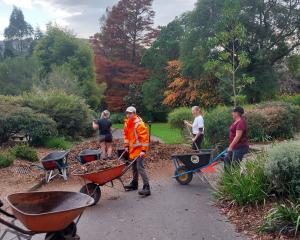Getting lost is the big attraction of hedge mazes. Gillian Vine reports on the re-creation of an English one.
I'm grateful that Andrew Mudge is on hand to show me the way. Without him, I'd certainly be well and truly lost in the maze at Cliveden - and there's no cheating, because the maze has iron fences to stop people breaking through the yew hedges.
Andrew whizzes through without hesitation. "I know it by heart," he says.
Head gardener at the National Trust property in Buckinghamshire for almost five years, Andrew explains that the maze, opened in April by TV gardener Alan Titchmarsh, faithfully replicates one from more than a century ago.
"The first Lord Astor designed it in 1894 and laid it out."
Lord Astor was obviously passionate about mazes for, after he gave Cliveden to his son in 1904, he went to Hever Castle, in Kent, and laid out the maze there.
Cliveden's "became derelict at least 50 years ago. We decided to reinstate it, which is what we have done," Andrew says.
He admits the decision was driven by a desire to increase Cliveden's visitor numbers, as the maze "adds to the family interest". It certainly seems to be working, as the complex attracted more than 1000 people a day in the first two months it was open and that number was expected to rise during the English summer.
That was not the only reason, as England has few hedge mazes left. Popular since Elizabethan times, they are high maintenance, which is probably why many disappeared.
The same size as the better-known Hampton Court maze, Cliveden's plan was in the record known as the Cliveden Album, so the National Trust had no lack of information when the decision was made to replant the maze.
Following the original, yew has been used but, in a departure from the 1894 design, iron railings have been added to stop children - and lost adults - breaking through the hedges.
The work took two years, as the ground had to be cleared and levelled, soil replaced and membrane laid under the gravel paths. The gravelly ground is ideal for yews, which will not tolerate wet feet.
"Part of the fun of a maze is getting lost, so we put in full-sized yews, 1100 of them, last October," Andrew says.
The railings and gates were locally crafted but the yew trees were grown at a specialist Dutch nursery, arriving in England as 60kg specimens that took two men to lift into their holes.
The trees thrived and eight months later, when the maze was opened, had reached their optimum height of 2m.
As well as the trees, 500m of paths were laid and a trickle irrigation system installed.
"Had we not, we'd have been in trouble this spring," Andrew says, because the weather was abnormally dry.
The cost, excluding labour, was about £200,000 ($NZ400,000), although part of that is being recovered by having supporters donate a tree. More than 600 of the yews (at £150 each) have been donated.
Getting there
Cliveden is some 35km to the west of London, within easy reach of Maidenhead. Garden admission is 8.50 ($NZ17) and the woodlands 3.60 ($NZ7.20) but holders of New Zealand Historic Places Trust membership cards are entitled to free entry. The garden is open from 10am until 5.30pm from mid-February until October 30, and from 10am until 4pm until December 31 (closed December 24-26). Tours of part of the house (1.50) are available on Thursdays and Sundays from April to October 27.
But wait, there's more
The maze is just a small part of Cliveden's 150ha of woodland and gardens.
Roughly rectangular in shape, the estate is bordered on the western side by the Thames and there are walks alongside the river. The gardens are extremely varied, from the formality of the parterre and Long Garden, with its statuary and topiary, to the soft form of the Secret Garden, laid out in the 1950s.
The estate is dotted with buildings, of which the Chinese pagoda is most photographed, and the Octagon Temple the most unusual thanks to its transformation from tea-house to chapel. A full day is needed to see everything.
Garden Viscount's creationCliveden is best known as the home of Nancy Astor (1879-1964), England's first woman MP and a famous political hostess in the 1930s, but to her father-in-law, William Waldorf, First Viscount Astor, must go the credit for creating the gardens that now draw thousands of visitors annually.
In the 1660s, the second Duke of Buckinghamshire had a hilltop flattened so a house could be built to take advantage of panoramic views down to the Thames Valley.
That house was replaced in 1850 by the present mansion, built for the second Duke of Sutherland in an Italianate style that complements the 17th century terraces below the south front. William Waldorf (later Lord Astor) bought Cliveden in 1893, and in 1942 the Astors gave the property to the National Trust, although members of the family lived in the house until 1966.
Leased by the National Trust, the mansion is now an upmarket hotel whose rates start at about $US850 $NZ995) a night.












